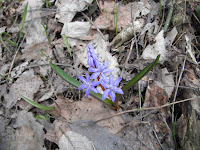In May the summer season really started in Moldova with
tropical temperatures: perfect weather for kayaking. Fortunately there are some big rivers in
Moldova, like the Nistru, where you can kayak. Usually this river is calm and
the environment green. However, there are not many places where kayaking is
offered. At least they are hard to find on internet.
No kayaking for
French students
When a group of French students came to Horodiste during the
last week of May they also planned one day of kayaking. On their request we
found a cheap company in Vadul lui Voda. (15 euro p.p for a whole day,
including guide)
To check out this company we went a day with team
Vent d’Est and some other people for a trip of around 18 kms. The guide was a Russian speaking man with a
beard and a lot of experience in kayaking.
Shortly after the start we had a break as our guide needed to buy some
cigarettes. The next stop was for a
picknick on shore while our guide had to buy lighter. Meanwhile we made a fire for shaslick (bbq).
Kayaking itself was relaxed, despite the need of some physical effort of the arms ofcourse. The way back, downstream was even better and much quicker.
However, the day we were supposed to kayak with the students of France, the guided didn't have the life-jackets as promised, despite emphasizing the need of it. Unfortunately this meant a no-go for the students. Instead they had a beach day in Vadul lui Voda.
Kayaking itself was relaxed, despite the need of some physical effort of the arms ofcourse. The way back, downstream was even better and much quicker.
However, the day we were supposed to kayak with the students of France, the guided didn't have the life-jackets as promised, despite emphasizing the need of it. Unfortunately this meant a no-go for the students. Instead they had a beach day in Vadul lui Voda.
Weekend of Kayaking
Next morning however I got a call if I wanted to volunteer
on a weekend trip kayaking in the North of Moldova. I said yes without even
thinking of the weather forecast (which was not really promising). This trip
was organized by Explore Moldova and we were with 16 people and 8 boats in
total.
The trip didn’t start as planned as there were problems in
transporting the kayaks: it is not always easy to organize something as you
often can’t rely on agreements. However this wasn’t a reason to cancel the trip
as another way of transporting the kayaks was found.
Instead of starting
kayaking in the evening we camped close to Bursuc and took off next day. Fortunately also the weather was different than expected:
not a single (rain) drop during the whole trip. While descending the Nistru we
saw on both sides green hills, sometimes rocky, we passed bathing cows along the
shore and regularly we stopped to stretch the legs and recharge energy (with a lot
of energetic food). Yes, we were taken well care off.
In the evening we made it a fire and cooked a meal while
enjoying the sunset . The next morning we continued peddling to Saharna. Again it was a beautiful day and at the end of the day we arrived close to the monastery.
Kayaking with Vent d'Est
I don't have to miss kayaking as Vent d'Est bought various inflatable kayaks. Starting in the village of Busiusca (around 6 km from Horodiste) we will offer a tour to Tipova Monastery... Here some pictures of the try-out.
 |
| Little hike |
 |
| Cooking on shore |
I don't have to miss kayaking as Vent d'Est bought various inflatable kayaks. Starting in the village of Busiusca (around 6 km from Horodiste) we will offer a tour to Tipova Monastery... Here some pictures of the try-out.
 |
| Frog around Buciusca |
 |
| View close to Tipova Monastery |
 |
| The kayaks |














































tisor.JPG)